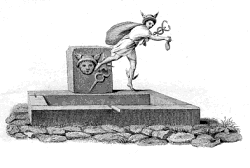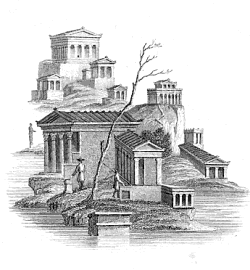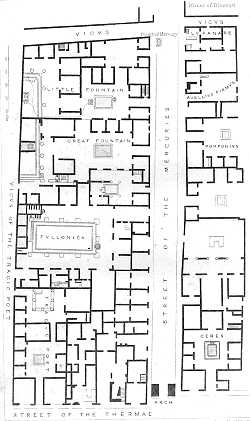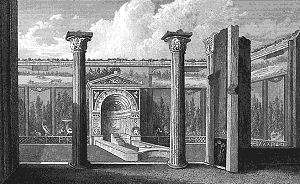Chapter X - House of the Fountain
|
 |
 |
 |
|
|
Adjoining the north wall of the fullonica is
a house, not particular from its dimensions, but
adorned with a fountain of so remarkable a structure,
that the habitation was distinguished, for some time,
by no other name. There is, however, the name of
Holconius Priscus near the door, who was, probably, the
protector of the proprietor.
An angle, in size nearly equal to one quarter of the
whole quadrangle occupied by this house, has been cut
off so as to form a small habitation, consisting only
of two little rooms, an entrance, and a peristyle of
three columns on each side, and uniting, by means of a
narrow door, with the fullonica.
|
|
The columns are placed round a compluvium, at
one extremity of which seem to have been more than the
usual inventions for water-works ; and certain dwarf
walls are observed, the uses of which are by no means
apparent. Vide plan, plate LX.
The house of the fountain is approached from the street
of the Mercuries by a handsome and lofty door ; and the
atrium is not less than fifty feet in length, by
forty broad. This atrium has its ala on
each side, regularly disposed, with its tablinum
in the centre ; and, beyond it, a portico with a small
court, the wall of which is painted to represent a
garden. In the tablinum is a pretty painting of
goats.
The whole ground floor of the house consists of eleven
rooms, without reckoning the alae, the
atrium, or the portico, and it seems to have
been the property of a person of consideration.
The ornaments, on the whole, do not differ much in
style from those already mentioned. The inner portico
has only three columns, and those of a degraded
Corinthian ; nor are they at equal distances from what
may be termed their antae. The fountain also,
though nearly in the middle of the garden, which is not
rectangular, is neither placed opposite an
intercolumniation, nor opposite the centre of the
tablinum, so that it must have lost much of its
effect.
|
|
|
|
Of the wall of the garden, more will be said in the
description of the view of it in plate LIII.
The colours and the plaster have long since
fallen.
There was a private entrance through the faux,
and a back passage from the vicus of the Tragic
Poet. Near the faux was also the staircase for
ascending to the upper floor.
|
|
In this house is the representation of a comic
scene, given in plate LIV.
The fountain itself was, however, the great source of
the modern celebrity of this habitation, presenting, in
fact, several circumstances calculated to strike an
observer. First its form, as will be seen by reference
to plate LIII, is precisely that which every citizen
would erect as a fountain at the bottom of his garden,
near the metropolis, in our own times, and such as may
be seen, at the present day, in the courts of most of
the palaces in Rome and throughout Italy, and proving
that, the worse the taste, the better chance it has of
being handed down for imitation from generation to
generation.
Secondly, the materials are of a singular description,
the whole being covered or incrusted with a sort of
mosaic, consisting of vitrified tesserae of
different colours, but in which blue predominates.
These are sometimes arranged in not inelegant patterns,
and the grand divisions, as well as the borders, are
entirely formed by, and ornamented with, real
sea-shells, neither calcined by the heat of the
eruption, nor changed by the lapse of so many
centuries.
|
|

It is so difficult to describe the exact nature of the
shells, in a manner perfectly intelligible to those who have
not studied them as a science, that they may be here
represented by a wooden cut.
It has been said that a boiler, or caldron, in this house,
was so contrived that hot water could, if necessary, be
conveyed to the cistern, or piscina, which advances in
front of the fountain. We are exceedingly apt to accuse the
ancients of ignorance in natural philosophy, an imputation
winch the excavations of Pompeii almost every day contradict.
Pliny states that water in leaden pipes will rise to the
height of the source whence it is derived ; and, in the
Sylvae of Statius, it is clearly shown that the Aqua Marcia
passed the Anio in leaden pipes. But Vitruvius, (VIII, 7),
gives instructions for the conveyance of water in tubes ; and
Pliny, (XXXI, 6), mentions the custom as common in his time.
The two fountains of Pompeii confirm the written
testimony.
Neither does it seem that the use of shells, in the
decorations of a fountain, is first noticed in the
excavations of Pompeii, for Cicero, in his Formian Villa,
appears to have employed them. A certain Philander, who wrote
notes on Vitruvius, has this remarkable passage : «Quod
veteres admiscuerint incrustationibus, potissimum fontium
fornicibus quod nostra aetas imitatur. Quod genus videtur in
Villa Ciceronis ad Formias interspersis purpuris,
peloridibus, caeterisque conchis».
The peloris was a species of shell-fish, about which the
ancients themselves seem in doubt, as ostrea and
echinus are both given as synonymous
interpretations.

|





